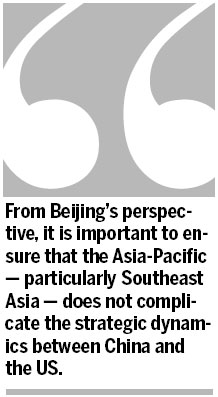For a new regional beginning
Updated: 2013-10-10 07:24
By Amitendu Palit (China Daily)
|
||||||||
On the heels of President Xi Jinping's recent trips to Malaysia and Indonesia, Premier Li Keqiang is visiting Brunei, Thailand and Vietnam. The visits of the top two leaders to Southeast Asian countries in quick succession may mark the beginning of a new relationship between China and the Association of Southeast Asian Nations based on economic pragmatism.
For some time now, territorial disputes in the South China Sea between China and some ASEAN member states have grabbed the headlines in Beijing's ties with a region with which its economic links have expanded rapidly. With the trade volume between China and ASEAN member states crossing $400 billion, China has become ASEAN's largest trade partner, while ASEAN is China's third largest. Investments and movement of people have also increased substantially between China and ASEAN over the last decade.
The economic developments, however, have been somewhat overshadowed by tensions in the South China Sea. Analysts and experts have been highlighting the tensions between China and some ASEAN member states, and the division within ASEAN. Repeated attention has been drawn to the failure of ASEAN to agree on the language of a concluding Communiqu at the Foreign Ministers meeting in Cambodia in July 2012 over disagreements on addressing territorial claims in the South China Sea.
The division among ASEAN member states on China and the South China Sea disputes is bad news both for China and the US. For Beijing, it shows the lack of uniform strategic influence across the region. For Washington, ASEAN's failure to draft a common communiqu on the South China Sea reflects its diplomatic failure in galvanizing ASEAN as a united front against China's expanding influence.
Indeed, ASEAN and the Asia-Pacific region have become the turf for US-China strategic competition since the US launched its "pivot to Asia" strategic policy. The most significant US initiative in establishing a deeper foothold in the region is the Trans-Pacific Partnership - a mega trade deal among 12 member states of Asia-Pacific Economic Cooperation from both sides of the Pacific that still excludes China.
With almost 40 percent of the global GDP and a quarter of global trade, the TPP is a sizeable economic bloc, and is expected to enlarge into a composite "Free Trade Area for the Asia-Pacific". The current composition and structure of the bloc indicates that other than economic motives, the TPP also serves the US foreign policy and security agenda of "balancing" China.

The TPP's "binding" nature and excessive focus on achieving convergence in cross-country regulations has led to the emergence of parallel integration efforts such as the Regional Comprehensive Economic Partnership. China has been actively pursuing economic integration efforts in the region. Such efforts arising from within Asia have ASEAN centrality and develop as "ASEAN+" frameworks.
The RCEP is a grouping of ASEAN members and six other countries with which it has bilateral free trade agreements. It is negotiating in a more "non-binding" and voluntary fashion than the TPP and is expected to be sensitive to the situation prevailing in a country while promoting trade liberalization. Some ASEAN member states, such as Singapore, Malaysia, Brunei and Vietnam, are part of the TPP and RCEP both. A concern voiced by many is whether the TPP and RCEP will become competing strategic instruments between the US and China, and whether that might deepen the strategic rift within ASEAN.
China has always focused on strong economic relations as the best antidote for preventing bilateral political tension from becoming unmanageable. Its deep economic links with ASEAN, formalized through the China-ASEAN FTA, has facilitated the extensive growth of regional supply chains between Chinese and Southeast Asian producers and has kept tensions over South China Sea within manageable limits. President Xi's and Premier Li's visits to Southeast Asia and emphasis on trade and investment as the building blocs of China-ASEAN ties affirm the criticality of economics in China's external engagement policies.
As the China-ASEAN strategic partnership completes a decade, both sides realize the importance of the Asia-Pacific region in global affairs. The region will be a key area both for the US and China to exert greater strategic influence. This is inevitable given the narrowing strategic gap between the US and China and the importance of Asia-Pacific from trade, business and human and natural resource perspectives.
The world is closely following the developments in this regard and US President Barack Obama's decision not to attend the APEC leaders' meeting in Bali, Indonesia, because of domestic reasons is being seen as a strategic victory for China.
From Beijing's perspective, it is important to ensure that the Asia-Pacific - particularly Southeast Asia - does not complicate the strategic dynamics between China and the US. It must objectively negotiate at the RCEP and also consider the possibility of joining the TPP in future for maximizing economic and strategic benefits. It should also continue to focus on trade and economics to manage disputes in the South China Sea, which can be addressed through greater bilateral consultations.
And the visits of President Xi and Premier Li to Southeast Asia appear to be resonating this strategy of economic pragmatism and bilateral engagement.
The author is head of Partnerships & Programme and senior research fellow at the Institute of South Asian Studies in the National University of Singapore.
(China Daily USA 10/10/2013 page12)
Most Viewed
Editor's Picks

|

|

|

|

|

|
Today's Top News
Americans to name panda cubs at Atlanta zoo
Obama remarks show China high on agenda
Hong Kong benefits from rising renminbi
China is a major contributor to global growth
China, Australia agree to quicken FTA talks
China hits at NASA's conference ban
US investors say they are less bullish on China
Wealthy shift focus to investment: Survey
US Weekly

|

|















